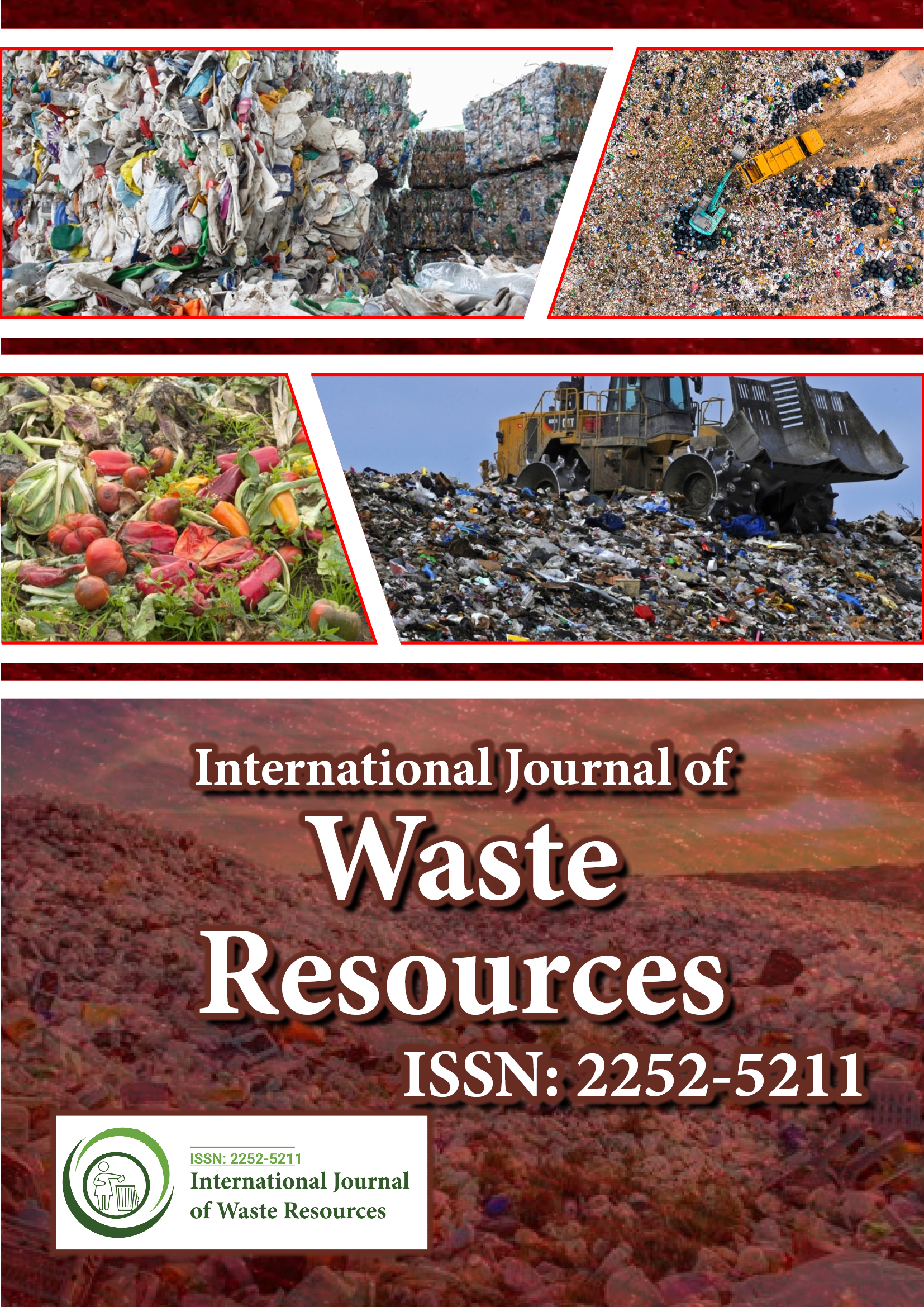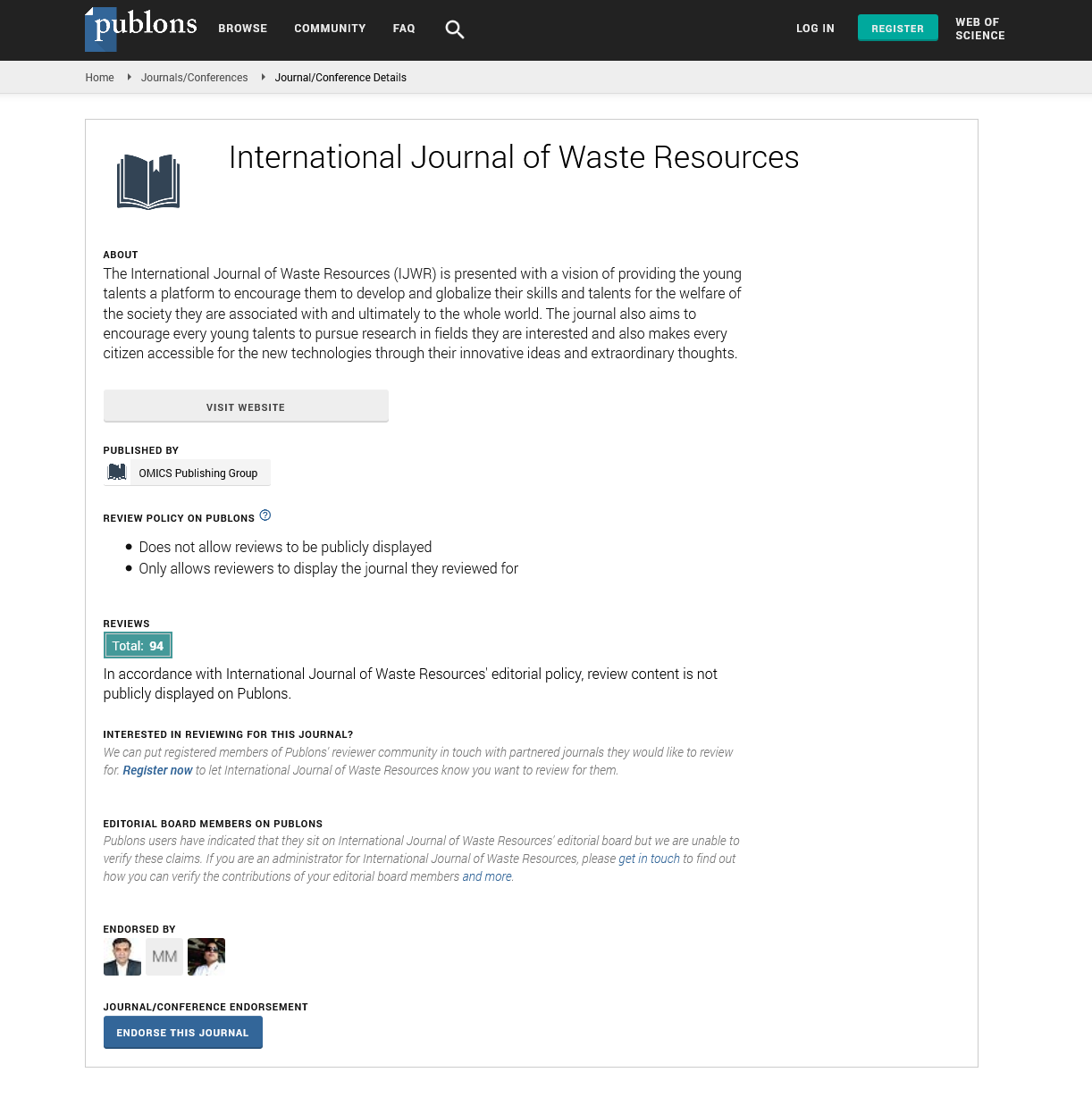Indexed In
- Open J Gate
- The Global Impact Factor (GIF)
- Open Archive Initiative
- VieSearch
- International Society of Universal Research in Sciences
- China National Knowledge Infrastructure (CNKI)
- CiteFactor
- Scimago
- Ulrich's Periodicals Directory
- Electronic Journals Library
- RefSeek
- Directory of Research Journal Indexing (DRJI)
- Hamdard University
- EBSCO A-Z
- Publons
- Google Scholar
Useful Links
Share This Page
Journal Flyer

Open Access Journals
- Agri and Aquaculture
- Biochemistry
- Bioinformatics & Systems Biology
- Business & Management
- Chemistry
- Clinical Sciences
- Engineering
- Food & Nutrition
- General Science
- Genetics & Molecular Biology
- Immunology & Microbiology
- Medical Sciences
- Neuroscience & Psychology
- Nursing & Health Care
- Pharmaceutical Sciences
Short Communication - (2025) Volume 15, Issue 1
Biomass and Biological Waste Treatment: Sustainable Solutions for Waste Management and Energy Recovery
Lynda Wibwo*Received: 31-Jan-2025, Manuscript No. IJWR-25-29255; Editor assigned: 03-Feb-2025, Pre QC No. IJWR-25-29255; Reviewed: 14-Feb-2025, QC No. IJWR-25-29255; Revised: 21-Feb-2025, Manuscript No. IJWR-25-29255; Published: 03-Mar-2025, DOI: 10.35248/2252-5211.25.15.609
References
- Ma X, Ma Y, Zhou J, Xiong S. The recycling of spent power battery: Economic benefits and policy suggestions. Earth Environ Sci. 2018;159(1):012017.
- Martins LS, Guimaraes LF, Junior AB, Tenorio JA, Espinosa DC. Electric car battery: An overview on global demand, recycling and future approaches towards sustainability. J Environ Manage. 2021;295:113091.
- O’Farrell K, Veit R, A’Vard D. Trend analysis and market assessment report. National Environment Protection Council Service Corporation; 2014.
- Wang X, Cheng G, Zhong X, Li MH. Trace elements in sub-alpine forest soils on the eastern edge of the Tibetan Plateau, China. Environ Geol. 2009;58(3):635-643.
- Syaichurrozi I, Sumardiono S. Predicting kinetic model of biogas production and biodegradability organic materials: Biogas production from vinasse at variation of COD/N ratio. Bioresour Technol. 2013;149:390-397.
[Crossref] [Google Scholar] [PubMed]
- Tang J, Wang XC, Hu Y, Zhang Y, Li Y. Effect of pH on lactic acid production from acidogenic fermentation of food waste with different types of inocula. Bioresour Technol. 2017;224:544-552.
[Crossref] [Google Scholar] [PubMed]
- Thiébaut G. Phosphorus and aquatic plants. Ecophysiol Plant Phosphorus Interact 2008:31-49.
- Tiwari S, Dixit S, Verma N. An effective means of biofiltration of heavy metal contaminated water bodies using aquatic weed Eichhornia crassipes. Environ Monit Assess. 2007;129(1):253-256.
[Crossref] [Google Scholar] [PubMed]
- Ahmad M, Ahmed OM, Schnepp B, Johnson PR. Engineered expression of broadly neutralizing antibodies against human immunodeficiency virus. Annu Rev Virol. 2017;4:491-510.
[Crossref] [Google Scholar] [PubMed]
- Gaudinski MR, Houser KV, Doriaâ??Rose NA. Safety and pharmacokinetics of broadly neutralizing human monoclonal antibody VRC07â??623LS in healthy adults. Lancet HIV. 2019;6(10):e667-e679.
[Crossref] [Google Scholar] [PubMed]
Description
In present world, marked by rapid industrialization and population growth, the generation of waste particularly organic and agricultural waste has become a pressing global concern. At the same time, the pursuit of sustainable energy alternatives has intensified, leading to a growing interest in biomass and biological waste treatment. This integrated approach offers a powerful solution by addressing two critical needs simultaneously: the reduction of waste and the production of renewable energy. Through the application of biological waste treatment technologies, organic materials can be transformed into valuable resources such as biogas, compost, and biofuels, aligning with the principles of the circular economy and enhancing environmental sustainability.
Biomass, which includes any organic matter derived from plant or animal sources, serves as the fundamental feedstock for biological waste treatment. It encompasses a wide range of materials, including agricultural residues, forestry by products, food scraps, animal manure, and sewage sludge. Rather than being discarded, these materials can be processed through natural biological mechanisms primarily driven by microbial activity to decompose and convert them into usable forms. This method not only supports eco-friendly waste disposal but is also typically more energy-efficient than traditional approaches [1].
Several biological processes have been developed to make use of different types of biomass. Among these, composting involves the aerobic decomposition of organic material by microorganisms, ultimately producing a nutrient-rich soil amendment that benefits agriculture and reduces methane emissions from landfills. Another widely used method, anaerobic digestion, takes place in the absence of oxygen and allows bacteria to break down organic waste into biogas a renewable energy source composed mainly of methane and carbon dioxide and a secondary product called digestate, which can be used as fertilizer [2]. Fermentation processes are also employed, primarily to convert the sugars found in certain biomass types into liquid biofuels such as bioethanol or biobutanol, which can be blended with conventional fuels to reduce dependency on fossil energy. Additionally, vermicomposting uses earthworms to break down organic material, yielding a highly effective organic fertilizer known as vermicompost. This method is particularly valued for its efficiency, low odor and nutrient-rich output [3].
The benefits of biomass and biological waste treatment are extensive, both environmentally and economically. These methods significantly reduce the volume of waste sent to landfills, helping to lower pollution levels and mitigate the harmful effects of leachate on soil and groundwater. They also support renewable energy generation, offering alternatives to fossil fuels and contributing to energy self-sufficiency, especially in rural areas [4]. Furthermore, these processes help cut greenhouse gas emissions by diverting organic waste from landfills and providing carbon-neutral or even carbon-negative energy solutions. They promote resource recovery by converting waste into compost and digestate, which enhances nutrient cycling and improves soil health. From an economic standpoint, these technologies generate employment opportunities in the green sector and help reduce costs related to waste disposal and chemical fertilizer use [5].
Despite the clear advantages, several challenges still hinder the widespread adoption of biological waste treatment. High initial investments are often required to develop infrastructure and implement new technologies. Public awareness and participation remain limited in many regions, particularly in the area of waste segregation, which is essential for effective treatment [6]. Additionally, the presence of non-biodegradable contaminants in the feedstock can disrupt biological processes. Operational complexities, such as maintaining the right conditions for microbial activity, and regulatory inconsistencies further complicate implementation efforts. Overcoming these obstacles will require strategic investments, comprehensive policy support, public education, and continuous innovation in treatment technologies [7].
Examples from around the world illustrate the success and potential of biological waste treatment systems. In India, biogas plants in rural areas provide clean cooking fuel while managing cow dung waste efficiently. Urban composting initiatives have reduced municipal waste volumes and supplied farmers with organic fertilizer. Germany stands out as a global leader in anaerobic digestion, with thousands of biogas plants converting organic waste into renewable energy. Sweden, through wellcoordinated municipal programs, converts almost all its organic waste into biogas and compost, showcasing a highly integrated and sustainable approach to waste management [8-10].
Looking ahead, the role of government and policy frameworks is critical in scaling up these solutions. Many governments are now offering incentives for the construction of biogas plants and composting units, enforcing mandatory waste segregation at the source, and promoting public-private partnerships to expand treatment capacity. Investments in research and development are also advancing bio-conversion technologies and supporting the emergence of integrated bio-refineries facilities that combine various biological treatment methods to achieve maximum resource recovery and minimal waste generation.
Conclusion
In conclusion, biomass and biological waste treatment represent a transformative model for waste management and renewable energy production. These technologies not only reduce environmental harm but also generate economic value and support the global transition to sustainable energy systems. As the demand for environmentally responsible solutions continues to grow, expanding infrastructure, strengthening community participation, and embracing innovation will be essential. By recognizing organic waste as a valuable resource rather than a burden, we take a vital step toward a cleaner, more resilient, and sustainable future.
Citation: Wibwo L (2025). Biomass and Biological Waste Treatment: Sustainable Solutions for Waste Management and Energy Recovery. Int J Waste Resour: 15:609.
Copyright: © 2025 Wibwo L. This is an open-access article distributed under the terms of the Creative Commons Attribution License, which permits unrestricted use, distribution, and reproduction in any medium, provided the original author and source are credited.

